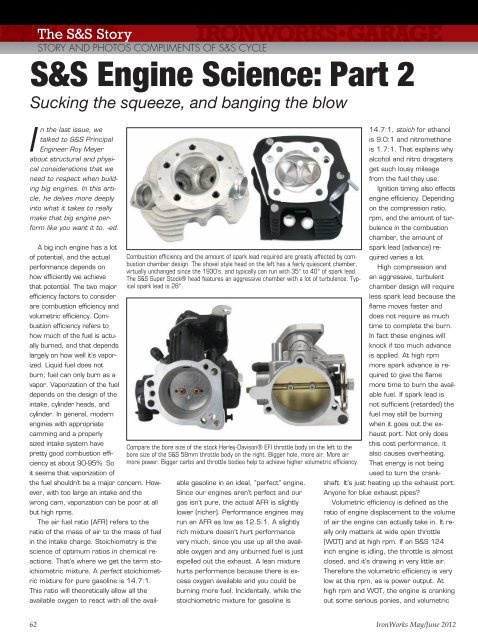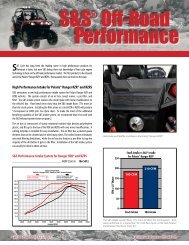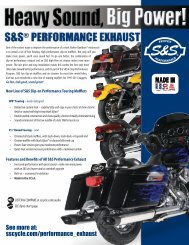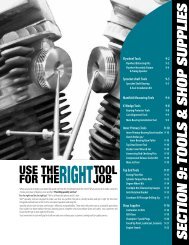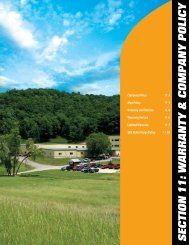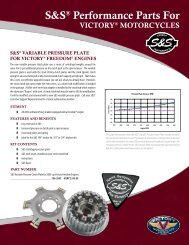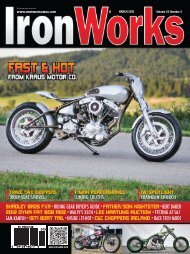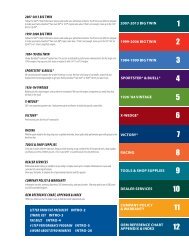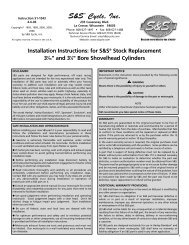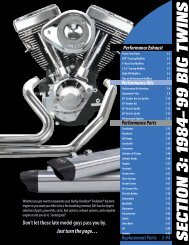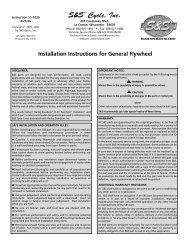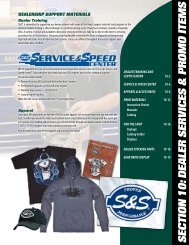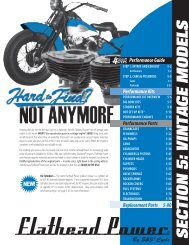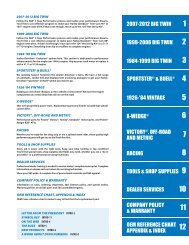SCAN FOR MORE INFO - S&S Cycle
SCAN FOR MORE INFO - S&S Cycle
SCAN FOR MORE INFO - S&S Cycle
You also want an ePaper? Increase the reach of your titles
YUMPU automatically turns print PDFs into web optimized ePapers that Google loves.
The S&S StorySTORY AND PHOTOS COMPLIMENTS OF S&S CYCLES&S Engine Science: Part 2Sucking the squeeze, and banging the blowIn the last issue, wetalked to S&S PrincipalEngineer Roy Meyerabout structural and physicalconsiderations that weneed to respect when buildingbig engines. In this article,he delves more deeplyinto what it takes to reallymake that big engine performlike you want it to. -ed.A big inch engine has a lotCombustion efficiency and the amount of spark lead required are greatly affected by combustionchamber design. The shovel style head on the left has a fairly quiescent chamber,virtually unchanged since the 1930’s, and typically can run with 35° to 40° of spark lead.The S&S Super Stock® head features an aggressive chamber with a lot of turbulence. Typicalspark lead is 28°.Compare the bore size of the stock Harley-Davison® EFI throttle body on the left to thebore size of the S&S 58mm throttle body on the right. Bigger hole, more air. More airmore power. Bigger carbs and throttle bodies help to achieve higher volumetric efficiency.of potential, and the actualperformance depends onhow efficiently we achievethat potential. The two majorefficiency factors to considerare combustion efficiency andvolumetric efficiency. Combustionefficiency refers tohow much of the fuel is actuallyburned, and that dependslargely on how well it’s vaporized.Liquid fuel does notburn; fuel can only burn as avapor. Vaporization of the fueldepends on the design of theintake, cylinder heads, andcylinder. In general, modernengines with appropriatecamming and a properlysized intake system havepretty good combustion efficiencyat about 90-95%. Soit seems that vaporization ofthe fuel shouldn’t be a major concern. However,with too large an intake and thewrong cam, vaporization can be poor at allbut high rpms.The air fuel ratio (AFR) refers to theratio of the mass of air to the mass of fuelin the intake charge. Stoichiometry is thescience of optimum ratios in chemical reactions.That’s where we get the term stoichiometricmixture. A perfect stoichiometricmixture for pure gasoline is 14.7:1.This ratio will theoretically allow all theavailable oxygen to react with all the availablegasoline in an ideal, “perfect” engine.Since our engines aren’t perfect and ourgas isn’t pure, the actual AFR is slightlylower (richer). Performance engines mayrun an AFR as low as 12.5:1. A slightlyrich mixture doesn’t hurt performancevery much, since you use up all the availableoxygen and any unburned fuel is justexpelled out the exhaust. A lean mixturehurts performance because there is excessoxygen available and you could beburning more fuel. Incidentally, while thestoichiometric mixture for gasoline is14.7:1, stoich for ethanolis 9.0:1 and nitromethaneis 1.7:1. That explains whyalcohol and nitro dragstersget such lousy mileagefrom the fuel they use.Ignition timing also effectsengine efficiency. Dependingon the compression ratio,rpm, and the amount of turbulencein the combustionchamber, the amount ofspark lead (advance) requiredvaries a lot.High compression andan aggressive, turbulentchamber design will requireless spark lead because theflame moves faster anddoes not require as muchtime to complete the burn.In fact these engines willknock if too much advanceis applied. At high rpmmore spark advance is requiredto give the flamemore time to burn the availablefuel. If spark lead isnot sufficient (retarded) thefuel may still be burningwhen it goes out the exhaustport. Not only doesthis cost performance, italso causes overheating.That energy is not beingused to turn the crankshaft.It’s just heating up the exhaust port.Anyone for blue exhaust pipes?Volumetric efficiency is defined as theratio of engine displacement to the volumeof air the engine can actually take in. It reallyonly matters at wide open throttle(WOT) and at high rpm. If an S&S 124inch engine is idling, the throttle is almostclosed, and it’s drawing in very little air.Therefore the volumetric efficiency is verylow at this rpm, as is power output. Athigh rpm and WOT, the engine is crankingout some serious ponies, and volumetric62 IronWorks May/June 2012


